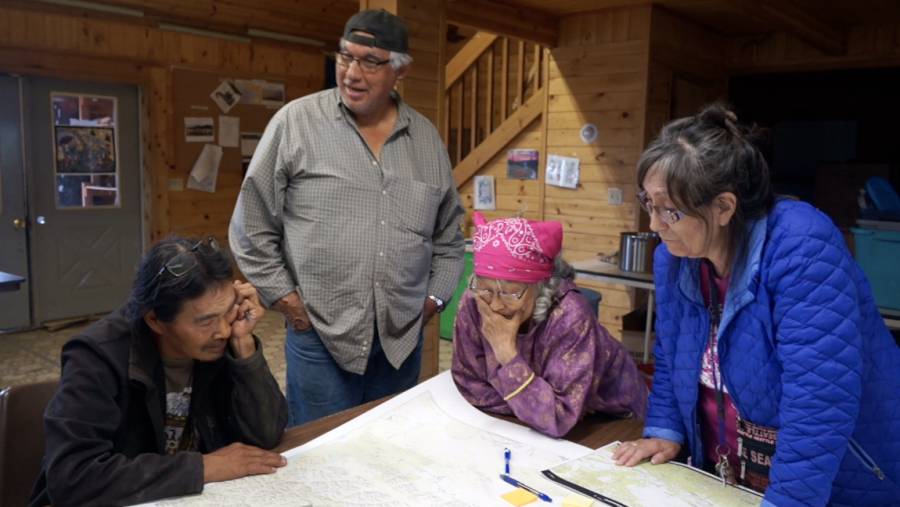On February 12, 1974, Federal District Judge George Boldt dramatically altered the Puget Sound salmon fishery. Boldt ruled that, under the terms of 1854-56 treaties, certain Indian groups had retained title to 50 percent of the western Washington State salmon resource. In making this interpretation, Boldt overturned the ground rules that had structured the development of the commercial salmon fishery in the state, managed as a common-property resource of the citizenry since statehood. Following the Boldt Decision, the salmon fishery was divided into two commercial fisheries: the "all-citizen" fishery and the "treaty-tribe" fishery.
The issue in U.S. vs. Washington, otherwise known as the Boldt Decision, was the character of the treaty right to take fish in common with all citizens. Where tribal salmon fishing previously had been restricted to reservation grounds, Boldt's decision permitted tribal fishermen protected access to off-reservation fishing grounds, consequently imposing severe restrictions on the common-property fishery of the all-citizen fishermen.
The problems afflicting the common-property and tribal salmon fishermen of Puget Sound have a long history. Municipal development and extensive logging destroyed salmon habitat throughout the early twentieth century, while the commercial salmon fishery developed in an unrestrained, often chaotic, fashion. The rapid growth and efficiency of commercial trolling, gill net and seine fleets, alongside burgeoning sport fishing, had begun to threaten the viability of the commercial salmon fishery in the sound as well as the inshore fisheries of tribal groups. Since tribal groups were the last in line to take salmon returning to natal streams, they were affected most severely. Non tribal, common-property fishermen were free to intercept salmon runs at any location in the marine waters of the state, subject to areal and temporal restrictions imposed by state management authorities upon all commercial fishermen. In contrast, Indian commercial fishermen, operating in waters adjacent to their reservation grounds. Many of those who did enter the common-property fishery did not possess the resources to compete effectively. Through the early 1970s, fishermen from the treaty tribes were taking only five percent of the total salmon catch. Commercial fishing techniques appropriated the resource before it entered the spawning grounds, where tribal people had always taken the bulk of their salmon catch for ceremonial, subsistence and commercial uses.
The political movement to restore Indian fishing rights developed in response to increasing interception of the salmon by common-property fisheries. The express intention of the Indian fishing rights movement as articulated by tribal leaders, was to achieve the return of a significant portion of the salmon runs to the traditional fisheries of the tribes.
The results of this intervention, a move designed to ensure the basis of tribal existence in accordance with the 1854-56 treaties, are becoming apparent only in the early 1980s. Rather than returning fish to traditional Indian river and inshore fisheries, the Boldt Decision appears to be encouraging the creation of a wealthy class of offshore, capital-intensive, treaty-tribe fishermen who are intercepting much of the resource before it reaches the traditional estuary and river fisheries of the tribes. In essence, the results of the federal intervention have accelerated the transformation of traditional tribal fisheries. In contrast to the competitive entrepreneurship associated with the common-property salmon fisheries, traditional tribal fishing has been characterized by strong collective, redistributive and ecological commitments. However, as treaty members adopt privately owned, capital-intensive fishing technologies such as purse-seining and marine gillnetting, new commitments are made that do not necessarily harmonize with traditional values.
While most treaty members do not operate expensive fishing operations, those who do take an extraordinarily large share of the Puget Sound salmon harvest. In 1982, the 30 treaty purse-seine vessel owners took $6.6 million of salmon, slightly less than one-third of total treaty harvest value. One tribe alone harvested approximately 40 percent of the total value of the 20 treaty tribes.
Conflicts now arise between tribes who can intercept the returning salmon runs in their usual and accustomed areas and tribes who must wait for those salmon, hoping that sufficient numbers will be left for them to harvest. Even within tribes who possess large capital-intensive fleets, conflict emerges as small-scale skiff and set-net fishermen charge that tribal purse seiners leave them few fish.
These unintended consequences of the Boldt Decision have a broader significance beyond the treaty fisheries. The tremendous social dislocation of non-tribal fishermen caused by the federal intervention was justified to the nontreaty population on the basis of the culturally distinctive Indian relation to the salmon resource. If this argument, used to legitimize the federal allocation policy, is undermined by post-Boldt shifts in tribal fishery, these changes will have ramifications for the popular legitimacy of the current fisheries regime.
Traditional Salmon Fishery
The salmon runs at issue in U.S. vs. Washington, spawn primarily in the streams, rivers and waterways that flow into Puget Sound and the Straits of Georgia. For millenia, this region has been among the most fertile of all salmon habitats on the Pacific Rim. Possessing a mild climate and relatively constant stream flow, the region provides excellent spawning conditions for almost all species of Pacific salmon. The Pacific salmon hatch and spend infancy in fresh water, feed and grow to maturity in the far reaches of the Pacific and at the end of their life cycle, return to spawn the next generation in the natal stream.
Native fishermen developed techniques that took advantage of the salmon's inerrant return, and their society came to be structured around the rhythms of the salmon harvest. The techniques used developed a social context that stressed kin and residence rights in the harvest.
Of necessarily, precontact society developed an ecological sensitivity which served to sustain the abundance of fish in their waters. Fishing groups had the right of usufruct but limited their harvest to accommodate upriver tribes and the needs of regeneration. This was in their interest; under the system of common property rights specific to a kin or village, overharvest would only damage the same group in future cycles. With a subsistence and barter economy, limited means of food preservation and small population, there was no incentive to overharvest.
Under pressure of increasing American settlement and the military presence of the US government, it became clear by the mid-nineteenth century that the dominion of the Salish (Indians) over the resources of Puget Sound was coming to an end. The tribes, hoping to retain a basis for their livelihood, and the US government, attempting to establish the preconditions for peaceful settlement of the area by its citizens, negotiated a series of treaties between 1854 and 1856. In return for conceding most of western Washington State, tribal "representatives" negotiated a settlement that gave the tribes monetary compensation, exclusive right to small parcels of land and certain guarantees, including "the right of taking fish at usual and accustomed grounds and stations...in common with all citizens of the Territory." Additionally, the tribes reserved the exclusive right of taking fish that passed through waterways on or adjacent to the reservation.
As long as the salmon continued to return in abundance to Puget Sound and neighboring regions, the substance of the guarantee that insured tribal fishing in common with the settlers was not in question. However, with the development of a Puget Sound canning industry in the late nineteenth century, salmon became a commodity; the relatively limited pressures generated by the needs of subsistence and barter were supplanted by the demands of the international capitalist economy. Simultaneously, the salmon runs were harmed by habitat degradation as stream-beds were used as sluices for the transport of logs to Puget Sound, as rapidly expanding urban centers dumped sewage and industrial effluent into the bays and as power dams were constructed on major salmon spawning rivers.
The Coast Salish, with some exceptions, did not successfully compete in the marine water commercial fisheries. Quickly outnumbered by immigrants who had greater access to capital, they remained primarily river and inshore fishermen and did not enter in significant numbers into the marine water gillnet, purse seine and troll fleets which were dominated by Scandinavians and later, Yugoslavians. As the size and efficiency of the marine water commercial fleets increased and the salmon runs declined, the returns to the tribal reservation fishery dwindled.
This situation became further complicated by government limitations of Indian fishing in the salmon natal streams to protect "brood stock" for regeneration. Clearly, this policy reflected a bias toward marine harvest. And federal courts would later determine, in the Puyallup decision, that the state had been using conservation requirements that placed an unfair burden upon Indian river fisheries.
In 1970, as the Indian share of the salmon fishery dwindled to five percent of the total harvest, the federal government, following a series of protest "fishins," filed suit against the state of Washington, acting as trustee for 14 treaty tribes. In his 1974 ruling, Boldt concluded that the state could regulate 50 percent of the salmon fishery, and that the other 50 percent would be managed by the 14 separate tribal entities (later expanded to 20 tribal entities).
In 1979, the Supreme Court upheld this decision. However, the Supreme Court altered Boldt's interpretation, holding that the 50 percent treaty tribe share was an upper limit which could be adjusted downward as the treaty tribe's "moderate living needs were met. Although it did not dispute the essence of Boldt's interpretation that the tribes possessed a "class right to a share of the fish" (Law Week 4983), it gave the tribes a variable property right to the fish rather than a fixed percentage.
The Supreme Court did not clarify the standards by which a "moderate living" would be determined. And by reference to "the livelihood of the tribe," the court seems to assume that tribal fishing will have a cooperative and redistributive character i.e. that the welfare of individual tribal members will be tied to the welfare of the tribe. It makes a similar assumption regarding division of the total Indian catch between the 20 tribal entities; i.e., that a cooperative ethic holds sway.
In light of new intertribal allocation data, this assumption seems problematic.
Transformation of the Treaty Fisheries
Since the Supreme Court upheld Boldt's finding in 1979, the treaty tribe fishermen have moved quickly to take a full 50 percent of the salmon runs in Puget Sound and adjacent water. However, this has not been a uniform process; some tribes and fishermen with greater access to the salmon resource and to capital have taken tremendous volumes of salmon while other tribes and individuals see little of the post-Boldt treaty share.
Seventy-five percent of treaty fishermen are still involved in river and estuary fisheries with labor-intensive fishing gear. Financial indications from the 1982 treaty fishing season indicate that the Boldt Decision has created a class of treaty fishermen who, by purchasing capital-intensive fishing vessels, enter interception fisheries. Given the high profits available to treaty fishermen who move into this entrepreneurial class, and the absence of legal guidelines delineating standards of equity between tribes and tribespeople, the stage is set for a laissez-faire expansion of the treaty fleet.
Whereas in precontact times, economic and technical limitations generally assured a natural distribution of the salmon runs between tribes, post-contact integration into the capitalist economy and concomitant use of modern fishing technology overcome these limitations. Using modern fishing technology, a tribe possessing superior location to intercept returning salmon can virtually cut off the return of salmon to upriver and down-Sound tribes.
The post-Boldt move into marine water, capital-intensive harvesting constitutes a move away from some traditional tribal values associated with river fishing. The developing treaty fishery resembles no Native common property fisheries far more than it does traditional Indian river and estuary fisheries.
The transition from an aboriginal society, organized along kinship lines, to a civil order, structured by the economics of a political society, is striking. With Coast Salish integration into the commodity economy, the catching of salmon for sale in the cash economy predominates over the catching of salmon for subsistence, barter and ceremonial usages.
Instead of being a means to the satisfaction of group ends, capital-intensive tools such as purse seiners and gillnetters become a means to satisfy private ends. Rather than contributing to the autonomy of the community of kin, a $100,000 fishing investment subordinates local needs to those of the larger social division of labor. Rather than being the central agency in the salmon harvest, the community benefits through a "trickle-down" effect. In this context, reference to a collective "tribal livelihood" seems questionable. As tribes begin to consider limiting entry by tribal members into the capital-intensive fisheries, this question will become more acute.
The Boldt Decision in a Larger Context
The historical justice of the treaty Indian claim to a share of the Puget Sound salmon resource is undeniable. However, the injustice experienced by the common property fishermen in Puget Sound also cannot be denied. Both groups were treated as if they had few rights against the eminent domain claimed by political structures. In the name of rectifying past injustice - the expropriation of aboriginal people from the salmon resource - the federal government, which had tolerated the development of a common property fleet, now acted with little regard or compensation for those whom its new interpretation of the 1854-56 treaties was to displace.
The federal intervention in the Washington State salmon fishery was necessary to protect the culturally unique relation of Indian people to the salmon resource. According to their argument, salmon is at the core of a culture complex; not only does it provide economic sustenance for tribespeople, but through participation in the harvest, it provides a focus for personal and collective identity. Given democratic commitment to the rights of the minority, the federal government must intervene to protect the rights of cultural minorities.
Nontreaty fishermen had, from the beginning of the litigation, charged that the moral arguments used to justify a private treaty share in the fishery were simply smokescreens behind which certain Indian individuals would become extremely wealthy. Now, following the undeniable destruction of their fishery, their suspicions appear to be confirmed.
Can the values of autonomy, participation and equality be subsumed under an economic calculus? The Salish attitude toward salmon which reflected the culture's immersion in the process of the harvest, the egalitarian ethos of the common property salmon fishermen and the role that salmon plays in the lives of sportsfishermen cannot be reduced simply to an economic standard. In addition, the reproduction of the salmon resource requires some form of social consensus regarding the costs of maintaining spawning habitat, the water quality of Puget Sound, state funding for salmon enhancement and hatcheries.
To arrive at a salmon fishery that has popular legitimacy and can address the cultural needs of both treaty Indians and nontreaty fishermen, elements of each culture's conception must be recognized. Evolving a new fisheries paradigm which would serve to regulate the Puget Sound salmon fishery with less conflict and greater recognition of cultural needs requires a far greater degree of self-regulation than is currently the case. If the cultural values of the Puget Sound fishing communities are to be respected and distribution of the resource into many hands is to be encouraged, then a different fishery is in order. A future definition for the Puget Sound fishery depends upon a definition of goals.
Article copyright Cultural Survival, Inc.



